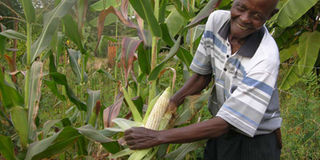Practices that make our semi-arid farms give us more yields

A thrilled Patrick Ndabi inspects his maize crops in his farm in Muthetheni, Machakos County. Lack of nitrogen in soils is the most limiting factor holding back agriculture. PHOTO | LEOPOLD OBI | NATION MEDIA GROUP
What you need to know:
- The farmers use both livestock manure and fertiliser during planting to enrich their soils.
- Global use of nitrogen fertiliser is forecast to grow by 1.4 per cent each year to above 119 million tonnes in 2018, according to a recent report published by the UN’s Food and Agriculture Organisation (FAO).
- But for arid areas such as Eastern Kenya, which includes Machakos, fertiliser is not the only shortcoming.
- Pest are such a menace especially when the crops begin to pod
Caroline Mutinda emerges from a forest of maize with a broad smile clutching straws of green gram in her arms.
She cultivates the legume on small plots in KwaChuvi, Kangundo in Machakos County.
Some of the plants, which she began growing last year, are intercropped with maize while others are planted on separate plots.
After school, the teacher normally returns to her farm to pick pods of the drying green grams.
Elsewhere in the county, in Muthetheni village, Patrick Ndabi is harvesting peas from quarter acre plot. Patrick doesn't intercrop the legumes with maize.
“I grow peas on quarter acre on rotational basis,” he explains. “This way I’m able to add nutrients to all my farms one season at a time.”
The farmers use both livestock manure and fertiliser during planting to enrich their soils.
Fertilisers make a profound difference in the area because the rusty red and black cotton soils, found in many parts of the county are deficient of organic matter and key nutrients such as nitrogen and phosphorus.
Robert Ngatia, an agronomist with Yara East Africa, says the amount of nitrogen fixed into the soil by legumes is not enough.
“A farmer can tell their soils are deficient of nutrients such as nitrogen or phosphorus by looking at the crop behaviours such as stunted growth, yellowing of leaves and poor yields,” says the agronomist, noting inorganic fertilisers help better soils.
The farmers buy legume seeds from Farm Input Promotions Africa (FiPS-Africa), which is also training them and linking them up with seed companies for easy access of clean quality planting materials, among other farm input. They grow N26 green gram varieties.
LACK OF NITROGEN
Global use of nitrogen fertiliser is forecast to grow by 1.4 per cent each year to above 119 million tonnes in 2018, according to a recent report published by the UN’s Food and Agriculture Organisation (FAO).
The lack of nitrogen in Africa’s soils is the “most limiting factor holding back agriculture on the continent.
As an alternative to fertiliser, Africa’s meagre crop yields are getting a boost from an edible and more environmentally friendly source like beans, peas and green grams.
But for arid areas such as Eastern Kenya, which includes Machakos, fertiliser is not the only shortcoming.
“Rains here are erratic,” explained Caroline, “As a result we grow legumes in shallow pits which ensure moisture retention.”
When preparing the pits, one digs a shallow trench measuring 2ft by 2ft and about 3ft deep.
“The top soil is set aside to be mixed with livestock manure before it is returned into the pit,” says Caroline, who dug 42 pits on her farm to host the grams.
She adds that in the next planting season she will plant maize in the plot which currently holds the legume and grow the legumes on a former maize field until her farms productivity is improved.
The holes hold enough water to support the plants even during drought. Pest are such a menace especially when the crops begin to pod, the farmers said.
“We sprayed insecticide during flowering to control the pest, we are expecting a bountiful harvest of green grams and beans this season,” says Caroline.





